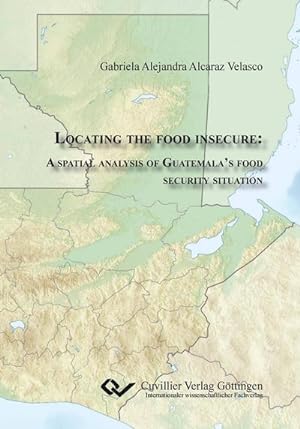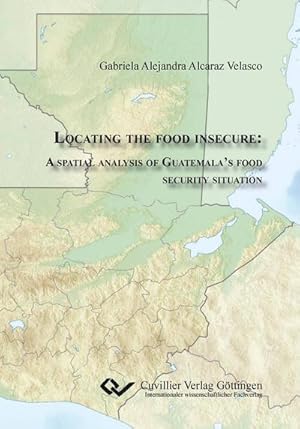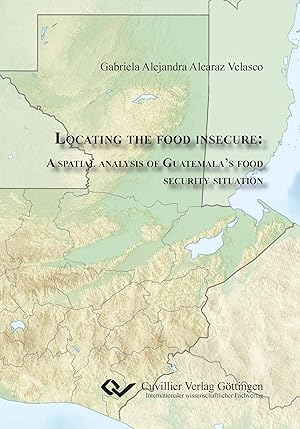GABRIELA ALEJANDRA ALCARAZ VELASCO (3 risultati)
Tipo di articolo
- Tutti gli articoli
- Libri (3)
- Riviste e Giornali
- Fumetti
- Spartiti
- Arte, Stampe e Poster
- Fotografie
- Mappe
-
Manoscritti e
Collezionismo cartaceo
Condizioni
- Tutte
- Nuovi
- Antichi o usati
Legatura
- Tutte
- Rilegato
- Brossura
Ulteriori caratteristiche
- Prima edizione
- Copia autografata
- Sovraccoperta
- Con foto
- No print on demand
Paese del venditore
Valutazione venditore
-
Locating the food insecure. A spatial analysis of Guatemala¿s food security situation
Editore: Cuvillier Nov 2011, 2011
ISBN 10: 3869559330ISBN 13: 9783869559339
Da: BuchWeltWeit Ludwig Meier e.K., Bergisch Gladbach, Germania
Libro Print on Demand
Taschenbuch. Condizione: Neu. This item is printed on demand - it takes 3-4 days longer - Neuware -International concerns about the widespread prevalence of food insecurity and undernutrition have promoted the adoption of common standards as framework for setting development objectives and assessing performance. As an example, Goal 1 of the Millennium Development Goals emphasizes the commitment of fighting hunger and undernutrition. During the past years the food insecurity situation aggravated in Guatemala. By 2007, Guatemala had the highest prevalence of stunted children under the age of 5 within the Latin American and Caribbean region. Its level of 54% was more than double than the prevalence observed in the other countries of the region.The research has as objectives i) the spatial exploration of the food security situation in the country, in consideration of the characteristics of the national food system and the local (Municipio) social and physical context, and ii) the creation of estimates of food insecurity incidence at the Municipio level (331 units) that can be spatially presented in a map. These maps can be innovative tools for targeting support to priority areas and guiding policy making. The data used stems from the 2002 population census, the 2006 ENCOVI (a nationally representative household survey), geographic information, and statistical national reports related to agriculture, undernutrition, and health. The contribution of the research to the literature is manifold. First, the description of the Guatemalan food system and the assessment of the households¿ food security situation through diverse indicators covering general aspects of availability, access, and utilization of food, as well as specific aspects related to the households¿ patterns and magnitude of food consumption and the inequality in consumption, offer a more comprehensive perspective on the overall food situation than traditional assessments. The latter rely only on household or individual-level data on calorie intake and anthropometric measurements. Second, the identification of spatial patterns demonstrates the importance of location characteristics for the analysis and modelling of food security in Guatemala. Lastly, the Municipio level food insecurity estimates contribute to the limited work worldwide on the mapping of food insecurity and undernutrition based on household and regional auxiliary data. The analysis enhances the understanding on the characteristics and spatial distribution of food insecurity in the country, which can be of use for development policy and national and local level planning in their efforts to address the population needs. 312 pp. Englisch.
-
Locating the food insecure. A spatial analysis of Guatemala¿s food security situation
Editore: Cuvillier, 2011
ISBN 10: 3869559330ISBN 13: 9783869559339
Da: AHA-BUCH GmbH, Einbeck, Germania
Libro Print on Demand
Taschenbuch. Condizione: Neu. nach der Bestellung gedruckt Neuware - Printed after ordering - International concerns about the widespread prevalence of food insecurity and undernutrition have promoted the adoption of common standards as framework for setting development objectives and assessing performance. As an example, Goal 1 of the Millennium Development Goals emphasizes the commitment of fighting hunger and undernutrition. During the past years the food insecurity situation aggravated in Guatemala. By 2007, Guatemala had the highest prevalence of stunted children under the age of 5 within the Latin American and Caribbean region. Its level of 54% was more than double than the prevalence observed in the other countries of the region.The research has as objectives i) the spatial exploration of the food security situation in the country, in consideration of the characteristics of the national food system and the local (Municipio) social and physical context, and ii) the creation of estimates of food insecurity incidence at the Municipio level (331 units) that can be spatially presented in a map. These maps can be innovative tools for targeting support to priority areas and guiding policy making. The data used stems from the 2002 population census, the 2006 ENCOVI (a nationally representative household survey), geographic information, and statistical national reports related to agriculture, undernutrition, and health. The contribution of the research to the literature is manifold. First, the description of the Guatemalan food system and the assessment of the households¿ food security situation through diverse indicators covering general aspects of availability, access, and utilization of food, as well as specific aspects related to the households¿ patterns and magnitude of food consumption and the inequality in consumption, offer a more comprehensive perspective on the overall food situation than traditional assessments. The latter rely only on household or individual-level data on calorie intake and anthropometric measurements. Second, the identification of spatial patterns demonstrates the importance of location characteristics for the analysis and modelling of food security in Guatemala. Lastly, the Municipio level food insecurity estimates contribute to the limited work worldwide on the mapping of food insecurity and undernutrition based on household and regional auxiliary data. The analysis enhances the understanding on the characteristics and spatial distribution of food insecurity in the country, which can be of use for development policy and national and local level planning in their efforts to address the population needs.
-
Locating the food insecure
Editore: Cuvillier Verlag, 2011
ISBN 10: 3869559330ISBN 13: 9783869559339
Da: moluna, Greven, Germania
Libro Print on Demand
Condizione: New. Dieser Artikel ist ein Print on Demand Artikel und wird nach Ihrer Bestellung fuer Sie gedruckt. KlappentextrnrnInternational concerns about the widespread prevalence of food insecurity and undernutrition have promoted the adoption of common standards as framework for setting development objectives and assessing performance. As an example, .




